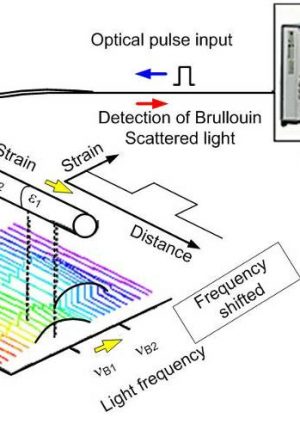Enhance Your Fibre Optic Projects With an Efficient Size Analyser
The combination of an effective diameter analyser right into fiber optic tasks offers as a pivotal aspect in achieving accuracy and consistency. By promoting exact size measurements, these analysers not only improve the high quality of setups however also mitigate potential compatibility problems amongst components.
Importance of Size Dimension
Determining the diameter of fibre optic cable televisions is a vital task that ensures optimal performance and dependability in communication systems. Accurate size dimension is crucial for numerous factors, mainly for preserving signal stability and reducing loss. A cord's size directly influences its capacity to transmit light efficiently; variances from the specified size can bring about increased attenuation, which impacts the general efficiency of the network.
Moreover, specific dimension is important during the installment and upkeep of fibre optic systems. An inappropriate fit in between connectors and wires can result in signal destruction or complete failure of interaction links. By making certain that diameters are within specified tolerances, professionals can improve compatibility between elements, leading to better system dependability.
On top of that, size measurement plays a substantial role in quality assurance throughout production. Consistency in the diameter of fibre optic wires is essential for making certain uniform efficiency throughout various batches. optical fibre diameter analyser. This uniformity assists producers maintain sector standards and promotes self-confidence among end-users
Attributes of a Reliable Analyser
An effective analyser for fiber optic projects should incorporate a number of key attributes that boost accuracy and functionality in diameter dimension. High-resolution optical sensing units are important for exact diameter analyses, making it possible for customers to detect also the slightest variations in fibre density. These sensors need to be matched by innovative calibration systems, ensuring constant efficiency throughout different conditions and products.
Secondly, a straightforward interface is crucial for promoting convenience of operation. This includes instinctive software program that enables smooth data input and result, along with visual depictions of the measurements taken. A portable design enhances use in different area settings, making it simpler to conduct assessments on-site.
In addition, the analyser ought to support multiple dimension modes, fitting numerous fiber kinds and applications. The ability to shop and get historic data is an additional crucial function, allowing individuals to track efficiency gradually and make informed decisions.
Advantages for Fibre Optic Projects
Carrying out a size analyser in fiber optic jobs uses significant advantages that significantly boost task performance and quality. One of the main advantages is the capability to make sure specific dimensions of fibre diameter, which is vital for maintaining optimal efficiency in fiber optic systems. Precise size readings assist in the recognition of inconsistencies that might bring about indicate destruction or loss, therefore making sure high-quality transmission.
Furthermore, the usage of a diameter analyser enhances the top quality control process. By automating measurement jobs, project groups can lower the moment invested in hand-operated evaluations, resulting in faster task completion and lowered work expenses. This performance also enables more rigorous screening click here for more procedures, leading to improved item dependability.
Additionally, consistency in fibre size measurements promotes compatibility with other fiber optic components, minimizing the risk of installation mistakes and improving total system efficiency. The consolidation of a diameter analyser not just aids in keeping sector requirements yet also fosters confidence in job deliverables.
Assimilation Into Existing Workflows
Incorporating a size analyser right into existing workflows can considerably boost the functional effectiveness of fibre optic jobs. By perfectly integrating this innovation, groups can accomplish exact measurements that are essential to preserving the honesty and performance of fibre optic systems. This assimilation allows for real-time data collection and evaluation, which can be important throughout the manufacturing and setup phases.
Furthermore, the ability to automate diameter measurement procedures decreases the potential for human mistake, making sure consistent quality assurance throughout the job lifecycle. The information created can be quickly shared across platforms, promoting partnership amongst designers, professionals, and job managers. This availability boosts decision-making and increases project timelines.

Selecting the Right Diameter Analyser
When picking a diameter analyser for fibre optic jobs, it is necessary to think about several key factors that directly effect measurement accuracy and operational performance. First, the resolution and precision of the analyser need to straighten with the specific demands of your project. Greater resolution tools can find minute variants in diameter, which is critical for ensuring optimal performance in fiber optic systems.
Next, analyze the rate of dimension. For projects with tight deadlines, a size analyser that uses rapid information purchase can significantly enhance productivity. In addition, consider the analyser's compatibility with existing systems and software application. A seamless combination minimizes configuration time and minimizes disruptions during procedures.
An additional essential element is the range of sizes the analyser can accommodate. By meticulously evaluating these factors, you can select a size analyser that improves the performance and precision of your fiber optic jobs.
Conclusion
In conclusion, the integration of an effective size analyser is paramount for enhancing fibre optic projects. Precise diameter dimensions make certain ideal performance and dependability while minimizing installment mistakes. Advanced features facilitate real-time data collection and conformity with sector standards, eventually boosting the quality of deliverables. By focusing on the option and execution of an appropriate analyser, job effectiveness is significantly enhanced, leading the way for effective results in fibre optic applications.
A dig this cable's size directly influences its capacity to send light successfully; variances from the defined size can lead to boosted attenuation, which impacts the general efficiency of the network.
